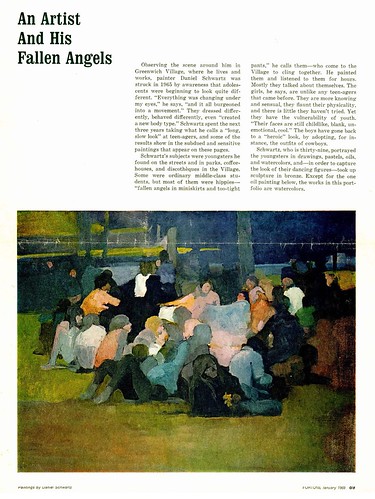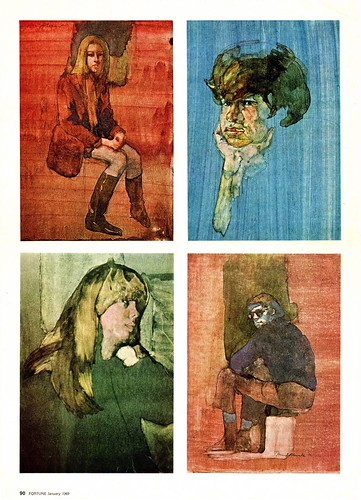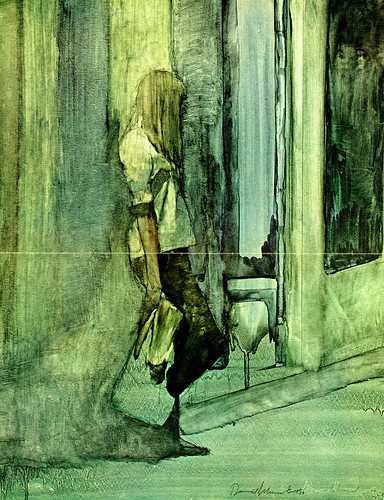‘Observing the scene around him in Greenwich Village, where he lives and works, painter Daniel Schwartz was struck in 1965 by awareness that adolescents were beginning to look quite different. “ Everything was changing under my eyes,” he says, “and it all burgeoned into a movement.” They dressed differently, behaved differently, even “created a new body type.” Schwartz spent the next three years taking what he calls a “long, slow look” at teenagers, and the results show in these subdued and sensitive paintings that appear on these pages’.
That was the lead into a 1969 Fortune magazine article called ‘An Artist And His Fallen Angeles’. I find it interesting that Schwartz, who was inducted into the Illustrators Hall of Fame, is referred to as an artist and not an illustrator, and his illustrations are referred to as simply paintings. Could it be that at that time, being recognized an “artist” or “painter”, may have carried more prestige?

The painting above was the only oil painting in the series that ran in Fortune magazine. At first glance, it is an interesting mosaic pattern of abstract shapes and colors. A second look reveals suggestions of bodies in various positions of carefree repose. Some are relating to each other and some are not. In most of the heads, Schwartz leaves out features, and some heads are merely a silhouette. He captures the first glimpse or impression of the scene, as though he were painting it quickly on location, before they began to depart. The soft range of colors suggests a warm sunny day, on perhaps a campus lawn or a park setting. At this point, he does not show us individual personalities, but a mass of young people in their own social environment.

Perhaps this is where Schwartz switched his medium from oils to watercolor... could it be that watercolor was faster, or maybe these paintings were done directly from life, and watercolor was more practical. Also, he now focuses on the individual personalities of his subjects. Each portrait has it’s own color theme, and each conveys a candid spontaneous gesture, that suggests little concern that they are being visually examined and recorded by the artist. They seem to be deep in their own thoughts, perhaps reversing the tables, and analyzing and examining an older stranger, capturing their image. After all, it was New York City, and Schwartz started painting these “fallen angeles”, as he called them, when he was about 33 years old... a much older man, from their perspective. This was the beginning of the Hippie generation, and Schwartz may have been the first to portray, in a national magazine, this early period of the Hippie movement, which soon exploded into a full blown social revolution.

These three figures grouped together, are nearly abstract shapes with only a suggestion of literal representation. The foreground figure and guitar, become one massive shape, with a more literal profile face. Like most of Schwartz’s watercolors, they are mainly monochromatic in hue, and in this case, there are muted variations of subtle gray tones... which might suggest an overcast day.
There is a feeling of aimlessness to these figures... a sense of just living the moment. As a witness to the transformation of these young people, I think the style Schwartz has developed is quite befitting to the subject. He shows little or no animation to his figures. They are mannequin like, and seem to be looking for something to become a part of, which is ultimately what happened... they became a part of a social phenomenon that ultimately swept the whole country.

Is this perhaps just a school girl waiting for a bus to take her home to her family? In the article, Schwartz said ‘some were ordinary middle class students, but most were hippies, “fallen angeles in mini skirts and too tight pants”, he calls them... who come to the Village to cling together’. Using the same transparent watercolor technique, Schwartz was probably inspired by the casual relaxed gesture, with her long straight blond hair nearly hiding her watchful face.
This reminds me a little of Edward Hopper’s paintings of stark lonely city people during the depression, usually in an all night diner or a cheap apartment or hotel. I think we will interpret these paintings, from our own experiences and point of view, and maybe that is what Schwartz really wants us to do.
Tomorrow: we will see how Daniel Schwartz illustrates the 1971 military court hearing of the Mylai massacre, during the Viet Nam War.
Every now and then you post a piece that just makes my jaw drop. The image of the girl possibly waiting for a bus is one such piece! Thanks so much for putting this blog together day after day. It really IS very much appreciated!!
ReplyDeleteHi Tom,
ReplyDeleteIt's great to see Daniel's astounding work. I remember some of these pieces from way back. I'm still in awe of his wonderful paintings. I worked in Detroit art studios back then doing hard-boiled automotive illustrations, we all admired Daniel's wonderful loose technique. Do you know if he is doing any illustrations now, or if he shows at a gallery ?
Thanks so much for your response Harry. It is much appreciated, especially comming from you. I always enjoy seeing your illustrations on TI and truly admire your tremendous talent.
ReplyDeleteAs far as I know, Daniel Schwartz is only doing fine art painting, but I'm not sure of that. Tomorrow, I give a URL that you can click on to see his recent paintings, at the end of the final post on Schwartz.
The work of Illustrators like Schwartz, make it easy and a pleasure for me to write about them. He has all the important ingredients.
Tom Watson
I was a bit behind on TI and when I opened the page was simply blown away to see these illustrations. Schwartz's complete yet relaxed control over his media and the intense compositions just knock me out!
ReplyDeleteAlways loved Daniel Schwartz artworks. Now I am studying them. Jim FitzPatrick. Ireland
ReplyDeleteAlways loved Daniel Schwartz artworks. Now I am studying them. Jim FitzPatrick. Ireland
ReplyDelete